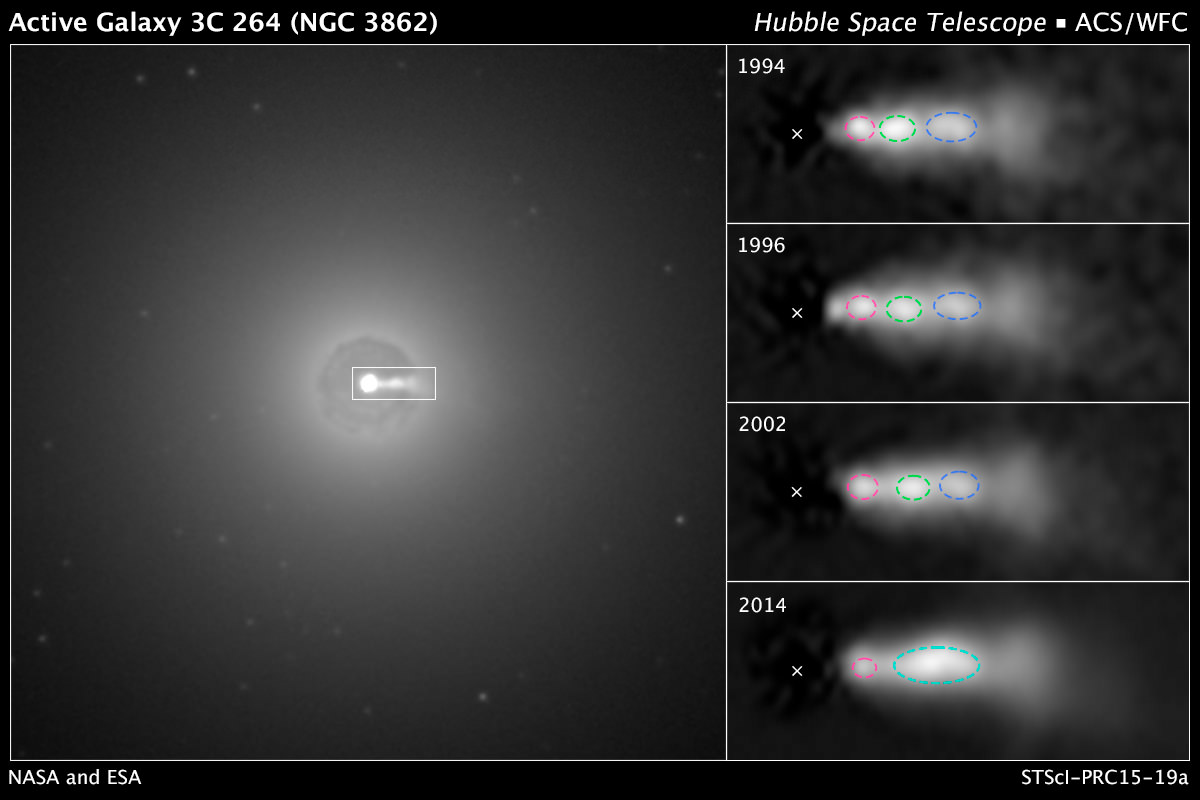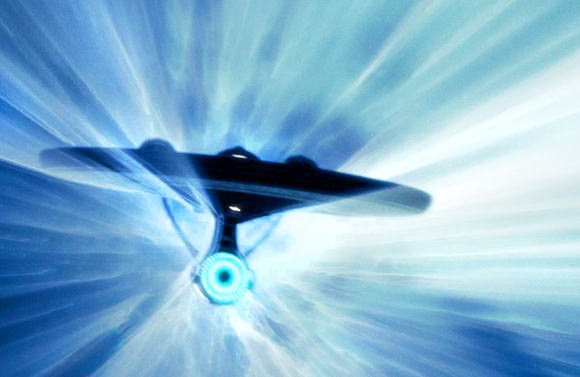I’m sure many readers of Universe Today are like me, fans of the science fiction genre. From the light sabres of Star Wars to the neuralyzer of Men in Black, science fiction has crazy inventions aplenty and once science fiction writers dream it, scientists and engineers try and create it. Perhaps the holy grail of science fiction creations is the warp drive from Star Trek and it is fair to say that many have tried to work out if it is even possible to travel faster than the speed of light. To date, alas, to no avail but if the warp drive eludes us, what about faster than light communication!
Continue reading “If Warp Drives are Impossible, Maybe Faster Than Light Communication is Still on the Table?”Hubble Captures a Collision in a Black Hole’s “Death Star” Beam
Even the Empire’s planet-blasting battle station has nothing compared to the immense energy being fired from the heart of NGC 3862, a supermassive black hole-harboring elliptical galaxy located 300 million light-years away.
And while jets of high-energy plasma coming from active galactic nuclei have been imaged before, for the first time activity within a jet has been observed in optical wavelengths, revealing a quite “forceful” collision of ejected material at near light speeds.
Using archived image data acquired by Hubble in 1994, 1996, and 2002 combined with new high-resolution images acquired in 2014, Eileen Meyer at the Space Telescope Science Institute (STScI) in Baltimore, Maryland identified movement in visible clumps of plasma within the jet emitted from the nucleus of NGC 3862 (aka 3C 264). One of the outwardly-moving larger clumps could be seen gaining on a slower, smaller one in front of it and the two eventually collide, creating a shockwave that brightens the resulting merged mass dramatically.
Such a collision has never been witnessed before, and certainly not thousands of light-years out from the central supermassive black hole.
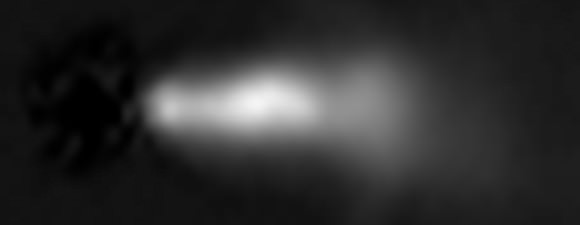
“Something like this has never been seen before in an extragalactic jet,” Meyer said. “This will allow us a very rare opportunity to see how the kinetic energy of the collision is dissipated into radiation.”
Jets like this are created when infalling material around an active (that is, “feeding”) supermassive black hole gets caught up in its powerful spinning and twisting magnetic fields. This accelerates the material even further and, rather than permitting it to descend down past the black hole’s event horizon, results in it getting shot out into space at velocities close to the speed of light.
Read more: Black Hole Jets May Be Molded by Magnetism
When material approaches the black hole in even amounts the jets are fairly consistent. But if the inflow is uneven, the jets can consist of clumps or knots traveling outward at different speeds.
Because of the motion of the galaxy itself related to our own, the speed of the clumps can appear to actually move faster than the speed of light, especially when – as seen in NGC 3862 – a large clump has already paved the way within the jet. In reality the light speed limit has not been broken, but the apparent superluminal motion so far from the SMBH indicates that the material was ejected extremely energetically.
It’s expected that the combined clusters of material will continue to brighten over the next several decades.
You can see a video of the observations below, and watch a Google+ Hangout with Hubble team members about these observations here.
Source: Hubble news center
Faster-Than-Light Lasers Could “Illuminate” the Universe
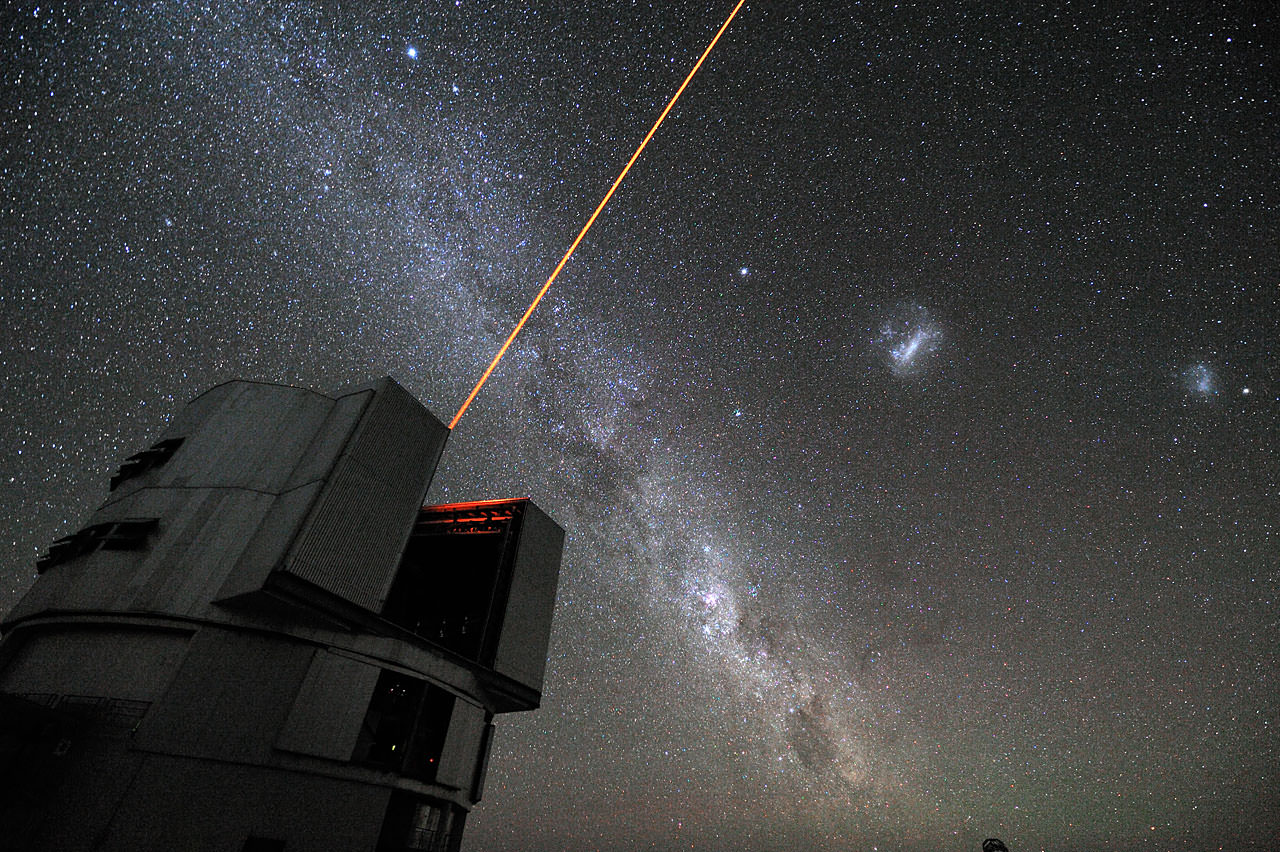
It’s a cornerstone of modern physics that nothing in the Universe is faster than the speed of light (c). However, Einstein’s theory of special relativity does allow for instances where certain influences appear to travel faster than light without violating causality. These are what is known as “photonic booms,” a concept similar to a sonic boom, where spots of light are made to move faster than c.
And according to a new study by Robert Nemiroff, a physics professor at Michigan Technological University (and co-creator of Astronomy Picture of the Day), this phenomena may help shine a light (no pun!) on the cosmos, helping us to map it with greater efficiency.
Consider the following scenario: if a laser is swept across a distant object – in this case, the Moon – the spot of laser light will move across the object at a speed greater than c. Basically, the collection of photons are accelerated past the speed of light as the spot traverses both the surface and depth of the object.
The resulting “photonic boom” occurs in the form of a flash, which is seen by the observer when the speed of the light drops from superluminal to below the speed of light. It is made possible by the fact that the spots contain no mass, thereby not violating the fundamental laws of Special Relativity.
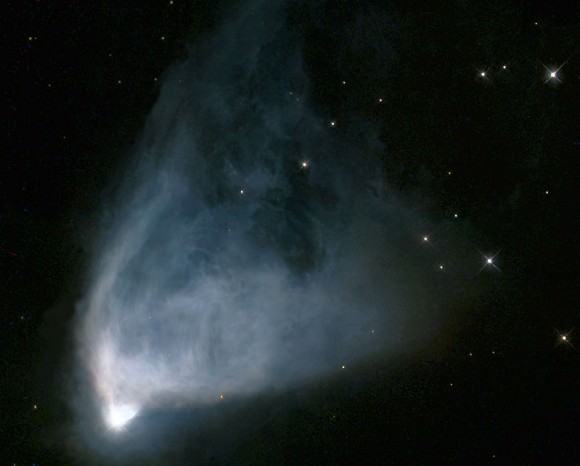
Another example occurs regularly in nature, where beams of light from a pulsar sweep across clouds of space-borne dust, creating a spherical shell of light and radiation that expands faster than c when it intersects a surface. Much the same is true of fast-moving shadows, where the speed can be much faster and not restricted to the speed of light if the surface is angular.
At a meeting of the American Astronomical Society in Seattle, Washington earlier this month, Nemiroff shared how these effects could be used to study the universe.
“Photonic booms happen around us quite frequently,” said Nemiroff in a press release, “but they are always too brief to notice. Out in the cosmos they last long enough to notice — but nobody has thought to look for them!”
Superluminal sweeps, he claims, could be used to reveal information on the 3-dimensional geometry and distance of stellar bodies like nearby planets, passing asteroids, and distant objects illuminated by pulsars. The key is finding ways to generate them or observe them accurately.
For the purposes of his study, Nemiroff considered two example scenarios. The first involved a beam being swept across a scattering spherical object – i.e. spots of light moving across the Moon and pulsar companions. In the second, the beam is swept across a “scattering planar wall or linear filament” – in this case, Hubble’s Variable Nebula.
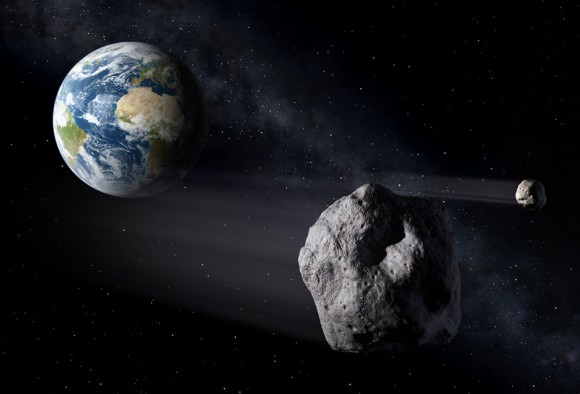
In the former case, asteroids could be mapped out in detail using a laser beam and a telescope equipped with a high-speed camera. The laser could be swept across the surface thousands of times a second and the flashes recorded. In the latter, shadows are observed passing between the bright star R Monocerotis and reflecting dust, at speeds so great that they create photonic booms that are visible for days or weeks.
This sort of imaging technique is fundamentally different from direct observations (which relies on lens photography), radar, and conventional lidar. It is also distinct from Cherenkov radiation – electromagnetic radiation emitted when charged particles pass through a medium at a speed greater than the speed of light in that medium. A case in point is the blue glow emitted by an underwater nuclear reactor.
Combined with the other approaches, it could allow scientists to gain a more complete picture of objects in our Solar System, and even distant cosmological bodies.
Nemiroff’s study accepted for publication by the Publications of the Astronomical Society of Australia, with a preliminary version available online at arXiv Astrophysics
Further reading:
Michigan Tech press release
Robert Nemiroff/Michigan Tech
Warp Drives May Come With a Killer Downside
[/caption]
Planning a little space travel to see some friends on Kepler 22b? Thinking of trying out your newly-installed FTL3000 Alcubierre Warp Drive to get you there in no time? Better not make it a surprise visit — your arrival may end up disintegrating anyone there when you show up.
“Warp” technology and faster-than-light (FTL) space travel has been a staple of science fiction for decades. The distances in space are just so vast and planetary systems — even within a single galaxy — are spaced so far apart, such a concept is needed to make casual human exploration feasible (and fit within the comforts of people’s imagination as well… nobody wants to think about Kirk and Spock bravely going to some alien planet while everyone they’ve ever known dies of old age!)
While many factors involving FTL travel are purely theoretical — and may remain in the realm of imagination for a very long time, if not ever — there are some concepts that play well with currently-accepted physics.
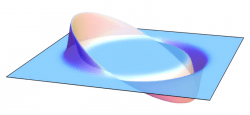
The Alcubierre warp drive is one of those concepts.
Proposed by Mexican theoretical physicist Miguel Alcubierre in 1994, the drive would propel a ship at superluminal speeds by creating a bubble of negative energy around it, expanding space (and time) behind the ship while compressing space in front of it. In much the same way that a surfer rides a wave, the bubble of space containing the ship and its passengers would be pushed at velocities not limited to the speed of light toward a destination.
Of course, when the ship reaches its destination it has to stop. And that’s when all hell breaks loose.
Researchers from the University of Sydney have done some advanced crunching of numbers regarding the effects of FTL space travel via Alcubierre drive, taking into consideration the many types of cosmic particles that would be encountered along the way. Space is not just an empty void between point A and point B… rather, it’s full of particles that have mass (as well as some that do not.) What the research team — led by Brendan McMonigal, Geraint Lewis, and Philip O’Byrne — has found is that these particles can get “swept up” into the warp bubble and focused into regions before and behind the ship, as well as within the warp bubble itself.
When the Alcubierre-driven ship decelerates from superluminal speed, the particles its bubble has gathered are released in energetic outbursts. In the case of forward-facing particles the outburst can be very energetic — enough to destroy anyone at the destination directly in front of the ship.
“Any people at the destination,” the team’s paper concludes, “would be gamma ray and high energy particle blasted into oblivion due to the extreme blueshifts for [forward] region particles.”
In other words, don’t expect much of a welcome party.
Another thing the team found is that the amount of energy released is dependent on the length of the superluminal journey, but there is potentially no limit on its intensity.
“Interestingly, the energy burst released upon arriving at the destination does not have an upper limit,” McMonigal told Universe Today in an email. “You can just keep on traveling for longer and longer distances to increase the energy that will be released as much as you like, one of the odd effects of General Relativity. Unfortunately, even for very short journeys the energy released is so large that you would completely obliterate anything in front of you.”
So how to avoid disintegrating your port of call? It may be as simple as just aiming your vessel a bit off to the side… or, it may not. The research only focused on the planar space in front of and behind the warp bubble; deadly postwarp particle beams could end up blown in all directions!
Luckily for Vulcans, Tatooinians and any acquaintances on Kepler 22b, the Alcubierre warp drive is still very much theoretical. While the mechanics work with Einstein’s General Theory of Relativity, the creation of negative energy densities is an as-of-yet unknown technology — and may be impossible.
Which could be a very good thing for us, should someone out there be planning a surprise visit our way!
Read more about Alcubierre warp drives here, and you can download the full University of Sydney team’s research paper here.
Thanks to Brendan McMonigal and Geraint Lewis for the extra information!
Main image © Paramount Pictures and CBS Studios. All rights reserved.


